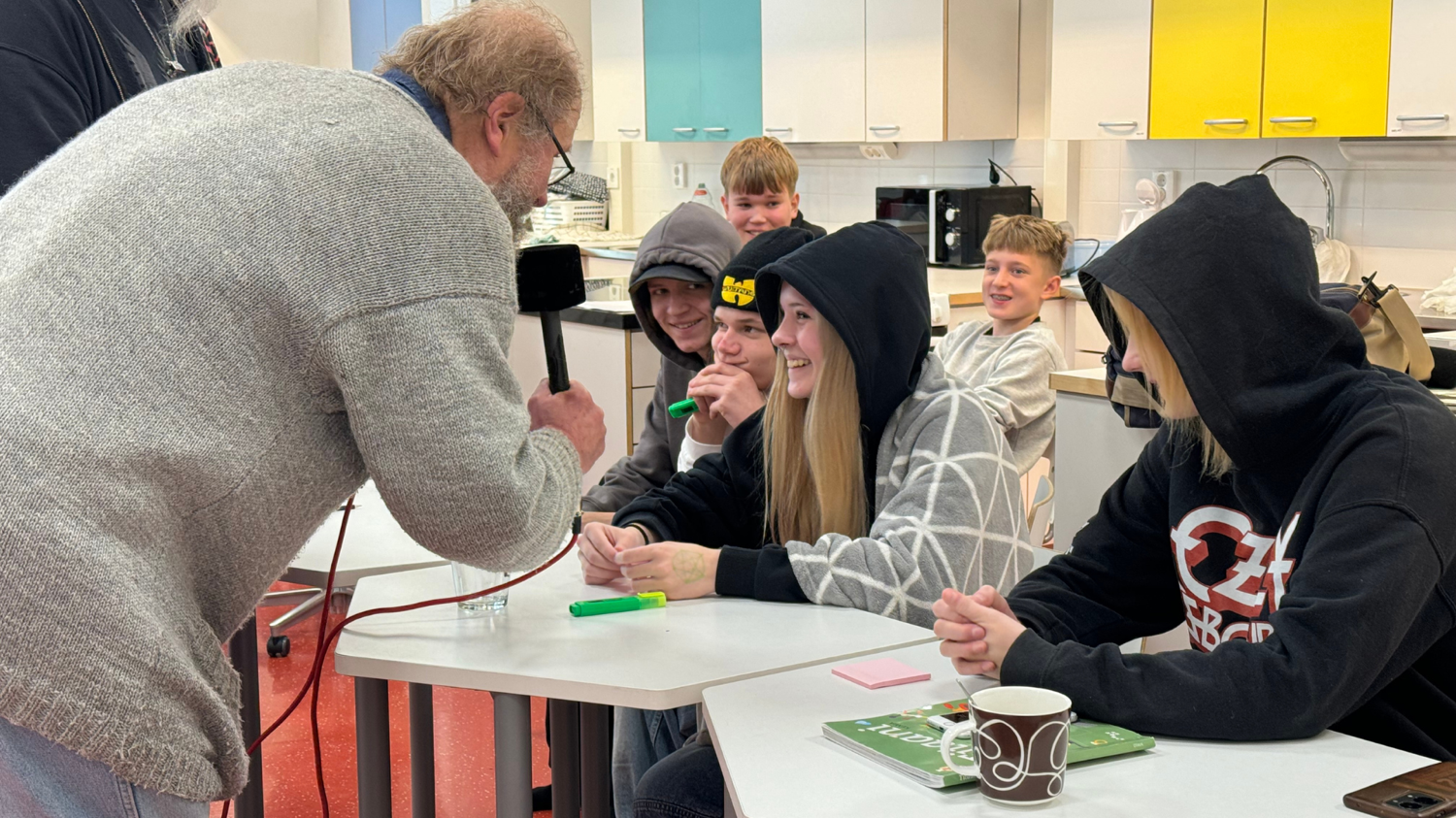Please note: Parts of this website will be included in the forthcoming CCI4Change publication, to be released by Xamk in December 2025. Therefore, if you wish to cite this material, please contact cai.weaver[at]xamk.fi. Thank you!
Case Study Finland
COOL Kotka
Collaboration
The "Cool Kotka" project was implemented by three partner organizations. From the City of Kotka, the departments of culture, urban development, and environmental services were involved. Partners included the regional development company Cursor Oy and the South-Eastern Finland University of Applied Sciences (XAMK). The role of cultural services in the city was to act as a bridge toward creative industries, the urban planning unit was responsible for communicating and clarifying the idea of the project to the CCIs and suggesting areal and societal context for the pilot projects, and environmental services brought expertise in energy use and climate issues. Cursor's task was to share information and contact the region's creative industry business field. XAMK experts monitored and documented the project and prepared a toolkit for presentations.
The overall project coordinator, Northern Dimension Partnership on Culture (NDPC), acted as a unifying and coordinating entity. The NDPC project manager and their team facilitated cooperation, assisted and advised project partners, and maintained contact with the Interreg Baltic Sea Region administration.
“Tackling climate change requires innovative thinking. CCIs can touch emotions which are the best drivers of action! To realize CCIs potential, fresh collaboration models and tools are needed to bring together diverse actors and translate creativity into a real change.”
- Marja Holopainen, Project Manager at Cursor

Pilots
Energeezer
The “Energeezer” pilot engaged young people in an energy-saving mentality via a computer game. In the project, games were produced both by young people during their own game jam sessions and by industry professionals in a longer production process. The professionals involved were Camilla Pentti, a versatile expert in visual arts, and Tatu Heinämäki, a visual artist and game designer.
In the first phase of the project, a game jam was organized for students at Kotka Lyceum. The goal was to engage young people in discussions and collaboratively create games that promote energy-saving in a way that resonates with them.
The Godot game engine workshop and game jam were held at Kotka Lyceum as a night school from November 8th to 9th, 2024, in collaboration with the school’s visual arts teacher, Marjut Siro. Participation was limited to 30 high school students, who were divided into seven teams. The theme of the game jam was "Energy Gobbler in Kotka", tasking the students with considering who or what the gobbler is and how it relates to Kotka. Participants approached the theme in different ways. They were very proactive in searching for information online, as well as utilizing AI assistants like ChatGPT. Motivation among students and mentors was high. At the end of the game jam, each participant had the opportunity to present their game and share a few words about it. The most rewarding part of the process was seeing how cool it is to create a functional game!
In the second phase of the project, a computer game titled “Energeezer”, designed by Camilla Pentti and Tatu Heinämäki, was developed.
The game centres around the character of the “Energeezer”, who is a person who doesn’t quite know how to save energy. They live their life wasting energy: They keep the oven warm so that it’s ready when hunger strikes, and their shower runs continuously just in case it’s needed. The player's task is to help the Energeezer live more efficiently.
With the player’s help, the Energeezer gradually learns: For example, once unnecessary lights are turned off and they are more likely to stay off when the player returns to the game. The game includes an energy consumption meter that shows the player’s progress. As the game progresses, new and surprising elements in the Energeezer’s apartment are revealed, which the player must teach them about. Ultimately, the Energeezer becomes energy-smart, and the player completes the game.
In the project application process, the Energeezer idea and its creators stood out due to their extensive previous experience and strong project concept. Computer games are an integral part of everyday life for many young people, so games were seen as a suitable medium for promoting energy-saving behaviours.
The Energeezer concept worked exceptionally well in engaging its target audience. Young people were able to grasp the theme and integrate it into the world of computer games. During the project, many exciting follow-up ideas emerged about other themes that could be further developed with young people through computer games. Discussions about future collaborations with the Energeezer team have already begun. For example, agreements were made with the school principal about a team visit to the school and the use of the game as social studies teaching material.
Play the Energeezer game
Banja Media
The Banja Media project produced short, humorous informational videos about energy consumption. The project was carried out in collaboration with students from educational institutions in Kotka. The production team included photographer and filmmaker, Juha Metso, nature filmmaker, photographer, cameraman, and editor, Mika Rokka, and author and children’s culture creator, Petri Pietiläinen.
The team planned and produced five playful informational videos. Their topics included saving electricity by lowering indoor temperatures, generating electricity for making coffee, carpooling, and saving hot water. All videos were filmed both horizontally with professional equipment for platforms like YouTube and vertically with a mobile phone in a TikTok-style format.
The central idea of the project was to further develop themes of sustainable development, energy conservation, and environmental protection in student workshops, shaping them into short films. The goal was to create videos that combine information and emotion with a touch of quirky humour. Unnecessary preachiness was removed, with the humour directed at the fearless yet simple inventor character played by scriptwriter Pietiläinen.
The project involved producing five short films and conducting two workshops at both Karhuvuori High School and the Ekami Vocational School. The aim was to inspire students to create their own cinematic commentary on sustainable development.
Karhuvuori High School students were first encouraged to think about their own ideas, after which a joint implementation plan was created. All students appeared in the film. The workshop was attended with enthusiasm and has paved the way for a longer workshop in future.
Ekami’s electrical engineering students had completed a sustainable development course prior to the workshop. Ultimately, a total of four videos were produced. Enthusiasm was high here as well, suggesting the need for a follow-up project. This could include another workshop where the produced video would be watched and evaluated, and a new version based on the same topic would be created using insights from the reflection process.
Watch more
Local Challenge
The Kymenlaakso region's economy is still quite focused on industrial production, and creative industries are only just developing. In Kotka, the challenge has been reaching creative industry companies in an area where there have been no direct platforms for creative and citizen-driven solutions.
However, some local artists and creative companies were successfully engaged during the planning phase of the pilot projects. They provided us with valuable perspectives and ideas for further refining the pilot experiments. Unfortunately, the availability of energy professionals for this project was limited. This led to a lack of diversity in the dialogue around the project, which weakened the thematic connection between energy and society. The absence of energy experts could be attributed to their busy schedules as well as insufficient clarification of the project's topic and their role within it. Another challenge was the segregation of employees in large organizations, such as municipalities, into their own industries and working areas (siloing). When working with such organizations, a lot of time is required to find suitable people and agree on a cooperation strategy.
In the Kotka region, the municipality and local businesses are making various energy-related technological improvements and cooperation projects with the resources available. Some solutions, such as improving the energy efficiency of heating systems in rental apartments, reduce the carbon footprint of the municipality's residents both directly and passively.
In situations like this, both parties need to improve their communication around the offered solutions to strengthen the image of citizens as sustainable energy consumers, encouraging them to make energy-conscious choices in their everyday lives. Circumstances where residents make their own decisions about their energy use, such as in single-family homes, are primarily influenced through advice and information.
Since the project was not limited to a specific community and it can be challenging to reach a large adult population in the short period, the project focused on cooperation with schools and educational institutions. This approach was successful thanks to the active engagement of teachers and students. It also made it easier to narrow down energy-related issues to everyday activities and focus on presenting them creatively through games and videos.

Capacity Building, Creating Outreach, and Launching an Open Call for Creatives
Outreach for creatives began in Kotka, where we embraced the expertise of Culture and Creative Industry (CCI) actors on choosing relevant themes for future demonstration pilots. We used the City of Kotka’s cultural department networks to find local and national creative actors. This was to extend the limits of available expertise and guarantee a high level of artistic quality. The regional development agency, Cursor, contacted energy companies that were interested in working with the creatives.
It was primarily individuals or companies within the CCIs that identified opportunities and attended meetings in Kotka. Approximately 20 CCI representatives attended the meetings, exchanging questions and ideas. The project team in Kotka, alongside Xamk experts, presented the project concept and provided a rough schedule of upcoming events.
Two meetings were held: The first for presenting the concept and the second for receiving feedback from CCI actors about the theme. In the second meeting, there were already some initial project ideas presented, and the participants were eager to get started. The meetings brought together a diverse group of creative actors, facilitating a collaborative, rather than competitive, atmosphere. The creatives were also able to quickly recognize and consider potential questions that may arise in the procurement process, such as the Intellectual Property Rights and intended life cycles of end products (e.g., games and videos).
Capacity building was a necessary phase and also a great way to raise interest among the CCI actors. It consisted of three parts:
Firstly, Cursor arranged a mini-course on how to prepare and answer bids in a public procurement. This was vital information for the CCI actors, many of whom were independent, self employed professionals. Many of the CCI actors that participated the first meeting also took part in this first capacity-building event.
The second part was a video from the Swedish partners presenting three cases and viewpoints on art-based innovation and new methods of collaboration between artists, cultural actors, and other sectors. The third part of the programme featured a lecture by Katriina Haikala, an experienced visual and social artist. Throughout her career, she has not only created art but has also demonstrated a keen awareness of branding and other financial aspects of artistry that are necessary for a successful creative career.
The open call that followed the capacity-building phase resulted in a good number of suggested pilots, from both local and national creatives. We even had entries from creative workgroups that did not take part in the initial process. This resulted in a more laborious pre-evaluation of the pilots. In the end, there were many good ideas that warranted roll-out, but unfortunately, we were only able to commission two pilot projects. The results of those projects suggest that the quality of the rejected projects would also have been high.

Value, Takeaways and Future Potential
The COOL Kotka project brought significant value by demonstrating how cross-sectoral collaboration can activate creative industries in traditionally industrial regions. One of the key achievements was the development of a shared identity through the COOL Kotka brand, which helped unify efforts and communicate energy-saving messages in a relatable and engaging way.
The project highlighted the importance of co-creation and youth engagement in promoting sustainable behaviours. Activities, such as game development workshops and student-driven video productions, not only empowered young people but also showcased how creativity can be used to address complex environmental topics. These participatory methods fostered a sense of ownership and enthusiasm that can be extended beyond the project itself. Students who participated in the game jams or video workshops can express interest in continuing creative work independently or inspire others to think more critically about their energy use. Educators can also explore the possibility of permanently integrating similar co-creative methods into their curriculum, blending art, technology, and sustainability.
Key lessons from the experience included the need for intermediaries, like Cursor Oy, to bridge gaps between sectors, and the value of capacity-building activities that equip stakeholders with practical tools, from navigating public procurement processes to engaging in creative communication. Additionally, the pilots revealed the potential for humour, storytelling, and interactive formats in making energy conservation more approachable.
Moving forward, the experience offers a strong foundation for scaling similar initiatives in other regions. Future potential lies in deepening partnerships between municipalities and creative sectors, continuing youth-led innovation, and embedding co-creation practices in urban development strategies. Ensuring the long-term impact of pilot projects remains a challenge, but it is also an opportunity to create lasting platforms for creative climate actions.
CCI4Change project at the city of Kotka homepage: CCI4Change-hanke | Kotkan kaupunki
Energeezer and the jam games: COOL Kotka - itch.io
Videos made by Banja Media: Banja Media | Kotkan kaupunki













